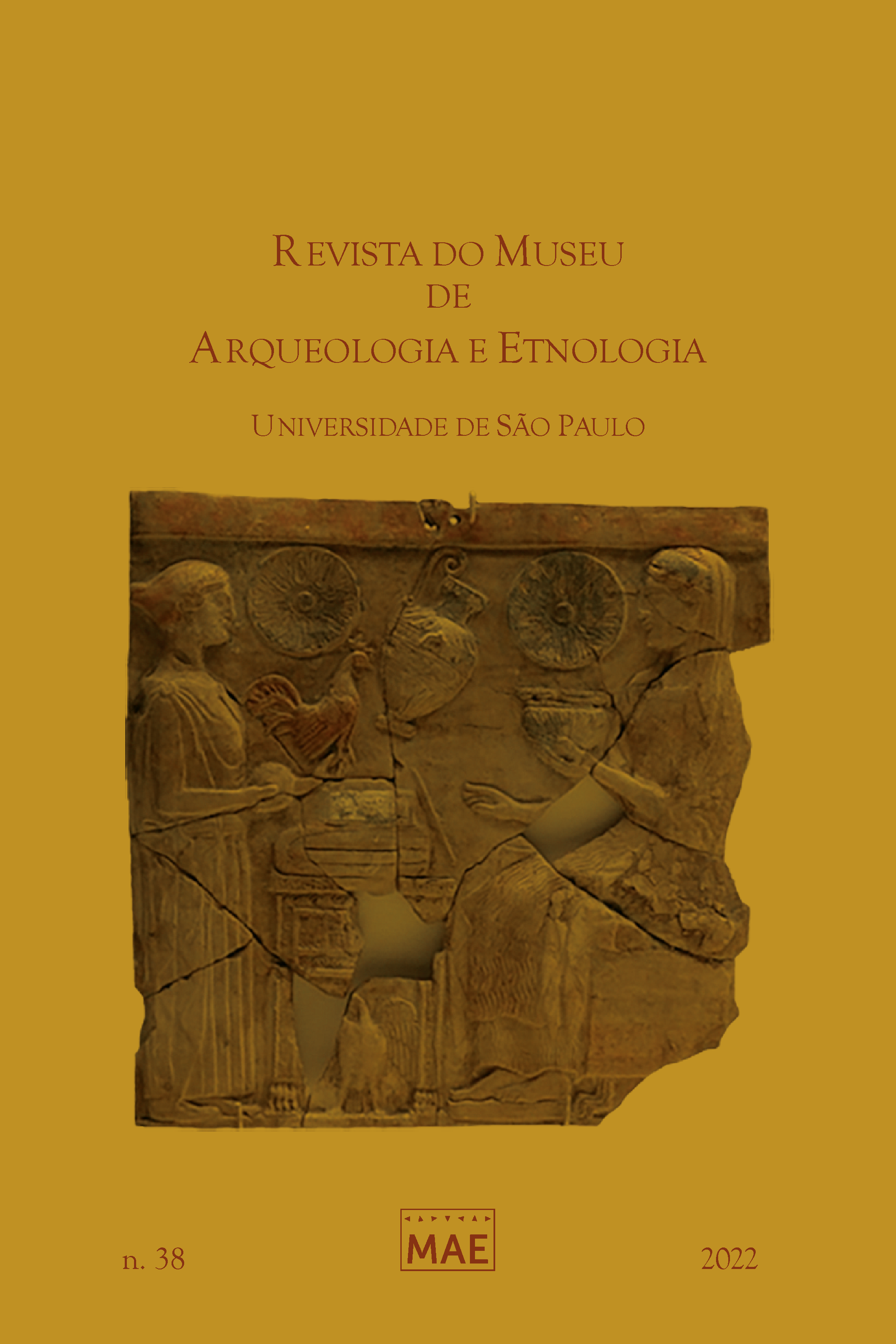Métodos históricos e arqueológicos para o estabelecimento da cronologia geral do Antigo Egito faraônico
DOI:
https://doi.org/10.11606/issn.2448-1750.revmae.2022.171788Keywords:
Ancient Egypt, Chronology, Methods, Archaeology, HistoryAbstract
General chronology of Pharaonic Ancient Egypt is the backbone of Egyptology. This article shows the historical and archaeological methods applied in its building. Pharaonic Ancient Egypt starts with the unification of Upper and Low Egypt by Narmer (or Menes) about five thousand years BP and thus remain until the Roman conquest in 30 BCE. The composition of the general chronology depends on sources from distinct periods to be unified in the end. Due to the long term, each period has its idiosyncrasies. The written and material sources bring their own problems, demanding the application of specific methods. The article presents these sources: Royal Lists (epigraphy and papyrus), archaeoastronomic (records of events and temples alignments), diplomatic letters, serialization of objects, evolution of building techniques and in the use of materials, tests of thermoluminescence, radiocarbon, dendrochronology, DNA and stratigraphic layers with volcanic ashes, as well as synchronization with chronologies of other civilizations. Then, it shows the general chronologies of Breasted (1905), Shaw (2000), Hornung et al. (2006) and Wilkinson (2010). It analyses the results of radiocarbon tests made by Ramsey et al. (2010), which suggest pushing the chronology in some decades back. It verifies criticisms like Bruin (2010) and Bietak (2013) have done about these results. Conclude that the debate is still far from be closed; however, there are available possibilities to refine the chronological detailing of each period with the application of suitable method. Lastly, the general chronologies that are now available are more reliably than those used before, but even they need be reviewed.
Downloads
References
Baines, John & Malek, Jaromir. (2000). Cultural Atlas of Ancient Egypt. Revised Edition. Checkmark Books, New York.
Bietak, Manfred. (2013). Antagonisms in Historical and Radiocarbon Chronology. In: Ramsey, Christopher & Shortland, Andrew. Radiocarbon and the Chronologies of Ancient Egypt. Oxbow Books, Oxford.
Bietak, Manfred & Czerny, Ernest (eds.). (2007). The Synchronization of Civilizations in the Eastern Mediterranean in the Second Millennium B.C. III. Verlag der Österreichischen Akademie der Wissenschaften, Wien.
Breasted, James. (1906). Ancient Records of Egypt. Vol. I. Chicago University Press, Chicago.
Bruins, Hendrik. (2010). Dating Ancient Egypt. In: Science, 328.
David, Rosalie. (2000). The Experience of Ancient Egypt. Routledge, London/New York.
Gardiner, Alan. (1959). The Royal Canon of Turin. University Press, Oxford.
Hawass, Zahi et al. (2010). Ancestry and Pathology in King Tutankhamun’s Family. JAMA, February 17, Vol 303, No. 7.
Hornung, Erik, Krauss, Rolf & Warburton, David. (2006). Ancient Egyptian Chronology. Brill, Leiden & Boston.
Jansen-Winkel, Karl. (2006). The relevance of genealogical information for Egyptian chronology. In: Originalveröffentlichung in: Ägypten und Levante 16, 257-273.
Kitchen, Keneth. (2007). Egyptian and Related Chronologies – Look, no sciences, no pots. In: Bietak, Manfred & Czerny, Ernest (eds.). The Synchronization of Civilizations in the Eastern Mediterranean in the Second Millennium B.C. III. Verlag der Österreichischen Akademie der Wissenschaften, Wien.
Kuniholm, P., Newton, M., Sherbiny, H., & Bassir, H. (2014). Dendrochronological Dating in Egypt: Work Accomplished and Future Prospects. Radiocarbon, 56(4), S93-S102.
Leprohon, Ronald. (2013). The Great Name. Society for Biblical Exploration, Atlanta.
Lull, José. (2006). La Astronomía en el Antiguo Egipto. PUV. Universitat de Valencia.
Lull, José. (2007). Sobre el eclipse solar del Papiro Demótico Berlín 13588 y el eclipse lunar de la crónica del príncipe Osorkon. In: Boletin de la Associación Española de Orientalistas, año XLIII, pp. 255-266.
Meneses, Ulpiano. (1983). A cultura material no estudo das sociedades antigas. I Simpósio Nacional de História Antiga. Universidade Federal da Paraíba, João Pessoal.
Ramsey, Christopher. (2008). Radiocarbon dating: revolutions in understanding. In: Archaeometry 50, 2, pp. 249–275.
Ramsey, Christopher et al. (2010). Radiocarbon-Based Chronology for Dynastic Egypt. In: Science 328.
Ray, John. (2008). The Rosetta Stone and the rebirth of Ancient Egypt. Profile Books, London.
Rainey, Anson & Scheidewind, William. (2015). The El-Amarna correspondence: a new edition of the cuneiform letters from the site of El-Amarna based on collations of all extant tablets. Brill, Leiden and Boston.
Schneider, Thomas. (2008). Periodizing Egyptian History: Manetho, Convention, and Beyond. In: Adam, K. (ed.). Historiographie in der Antike (Zeitschrift für die alttestamentliche Wissenschaft, Beiheft 373), Berlin, pp. 183-197.
Shaw, Ian. (2000). The Oxford History of Ancient Egypt. Oxford University Press, Oxford.
Shortland, Andrew et al. (2013). Radiocarbon and the Chronologies of Ancient Egypt. Oxbow Books, Oxford.
Spence, Kate. (2000). Ancient Egyptian chronology and the astronomical orientation of pyramids. Nature Maganize, vol. 8.
Taylor, R. & Bar-Yosef, Ofer. (2016). Radiocarbon Dating: an Archaeological Perspective. 2nd edition. Routhledge, New York.
Trigger, Bruce. (2004). História do Pensamento Arqueológico. 2a ed. Odisseus, São Paulo.
Wadell, Wendy. (trad.). (1964). Manetho. Harvard University Press, Cambridge.
Wilkinson, Toby. (2000). Royal Annals of Ancient Egypt. Routhledge, London.
Wilkinson, Toby. (2010). The Rise and Fall of Ancient Egypt. Bloomsbury, London.
Wells, Ronald. (1987). The Amarna M, X, K boundary stellae date: a modern calendar equivalent. In: Studien zur Altägyptischen Kultur, Bd. 14, pp. 313-333.
Downloads
Published
Issue
Section
License
Copyright (c) 2022 Thomas Henrique de Toledo Stella

This work is licensed under a Creative Commons Attribution-NonCommercial-NoDerivatives 4.0 International License.
Funding data
-
Coordenação de Aperfeiçoamento de Pessoal de Nível Superior
Grant numbers 001













